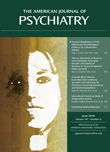Resolving the Discrepancy in Childhood Bipolar High-Risk Study Findings
To the Editor: In their article, published in the March 2010 issue of the Journal, Boris Birmaher, M.D., et al. (1) discussed some factors that may explain why their findings in preschool-age children of parents with bipolar disorder appeared to contradict those of other studies. However, there are other reasons for the obvious contradictions, including the different methods of recruitment, assessment, and symptom definition.
The Pittsburgh Bipolar Offspring Study (BIOS) ascertained many high-risk families through advertisement, confirmed parental bipolar disorder on cross-sectional assessment, and allowed for psychiatric comorbidity amongst co-parents. This differs from studies in which the parent was diagnosed with bipolar disorder based on structured interviews, combined with all available clinical information, and in which well biological co-parents were required (2, 3). This also differs from studies that recruited parents largely from specialty clinics or patient support groups (4, 5).
The variation in recruitment may explain the high rates of comorbid diagnoses in BIOS parents. Furthermore, the unexpectedly high rates of substance use, conduct disorder, and attention deficit hyperactivity disorder (ADHD) in the female probands suggest that the offspring sample may be enriched for genetic susceptibility to these conditions.
Second, other studies that used only experienced clinicians to directly assess offspring did not report elevated rates of ADHD in high-risk children (2–6), unlike the BIOS study, in which parents were interviewed about the presence of psychiatric disorders in their children. Furthermore, the finding that the caregivers and teachers were not able to differentiate high-risk offspring from comparison offspring raises questions about the reliability of the diagnostic information.
Finally, bipolar disorder criteria for children are not developmentally sensitive, and psychiatric disorders appear to evolve from heterotypic origins (nonspecific to specific). Thus, labeling symptoms in preschoolers as manic may be premature until the symptoms are proven to be related to bipolar disorder. Consistent with the findings, in the Amish study (2), manic-like symptoms appeared only later in development, and this study along with others, (4–7) failed to identify a single case of prepubertal mania. Irritable mood, distractibility, increased activity, poor judgment, and unusual energy in preschoolers may not be symptoms of mania, but rather indicators of risk for a variety of future outcomes and/or a mixture of developmentally appropriate behaviors that ill parents find challenging.
In closing, we share the view of Dr. Birmaher et al. that longitudinal observation over the entire risk period will clarify the natural history of bipolar disorder in high-risk children.
1 : Psychiatric disorders in preschool offspring of parents with bipolar disorder: the Pittsburgh Bipolar Offspring Study (BIOS). Am J Psychiatry 2010; 167:321–330 Link, Google Scholar
2 : A 10-year prospective study of prodromal patterns for bipolar disorder among Amish youth. J Am Acad Child Adolesc Psychiatry 2005; 44:1104–1111 Crossref, Medline, Google Scholar
3 : Early stages in the development of bipolar disorder. J Affect Disord 2010; 121:127–135 Crossref, Google Scholar
4 : Five-year prospective outcome of psychopathology in the adolescent offspring of bipolar parents. Bipolar Disord 2005; 7:344–350 Crossref, Medline, Google Scholar
5 : Affective disorders in referred children and younger siblings of manic-depressives: mode of onset and prospective course. Arch Gen Psychiatry 1985; 42:996–1003 Crossref, Medline, Google Scholar
6 : Longitudinal study of diagnoses in children of women with unipolar and bipolar affective disorder. Arch Gen Psychiatry 1990; 47:1112–1117 Crossref, Medline, Google Scholar
7 : Early course of bipolar disorder in high-risk offspring: prospective study. Br J Psychiatry 2009; 195:457–458 Crossref, Medline, Google Scholar



